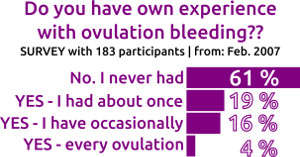What are the 3 secrets that ovulation bleeding can tell you? In this article, you’ll discover why ovulation bleeding happens, how you can recognize it, and if it tells you when ovulation happens.
For many women, ovulation bleeding seems unusual or mysterious, because knowledge about the different types of bleeding is often very limited. Women start or stop taking birth control pills, and suddenly experience bleeding in the middle of their cycles. But what does this midcycle bleeding tell us, why does it happen, and can it really tell us when ovulation occurs? As a fertility counselor, I’ve seen many cycles with ovulation bleeding, and in this article, I’ll tell you the three major secrets of ovulation bleeding. But that’s enough introduction – let’s get started!
1. What is ovulation bleeding, and how can you recognize it?
When reddish brown spotting occurs during your most fertile time, it is called ovulation bleeding. In this context, this is how the most fertile time is defined: From the time that you see cervical mucus for the first time to the first higher measurement of the basal temperature (in accordance with the rules of the Symptothermal method, which can determine the time of ovulation within a few days).
The example cycle begins with menstruation. The example woman is in her second cycle after having stopped taking birth control pills. Her menstruation lasts 5 days. On the first three days, she has heavy bleeding, and then the bleeding is lighter. On the 10th day of the cycle, she can see cervical mucus for the first time, and the most fertile days begin. On the 18th day of the cycle, she can determine the first higher measurement (1st hM) of the temperature in accordance with the rules of the Symptothermal method.

On the 16th day of her cycle, the woman notices midcycle bleeding that is noticeably less heavy than her standard period. On the following day, she still has a little spotting. From the 16th day of the cycle to the 18th day of the cycle, she can see stretchy cervical mucus as well as the bleeding, and she feels moist at the entrance to her vagina. On the 16th day of the cycle, she also notices slight pain in her abdomen, which she identifies as midcycle pain. Because this is midcycle bleeding in the most fertile time in close connection to other signs of ovulation, such as Ovulation pain and an increase in temperature, this midcycle bleeding can be clearly identified as ovulation bleeding.
2. Why does ovulation bleeding happen?
The medical causes of ovulation bleeding are not yet fully understood. Currently, scientists believe that estrogen levels drop drastically in some women shortly before ovulation. They fall below a critical level that is necessary to keep all of the uterine lining that has developed during the follicular phase. Consequently, a (generally small) amount of the uterine lining is sloughed off, which can be observed in short midcycle bleeding, or “ovulation bleeding.”
3. Does ovulation bleeding happen during every ovulation?

The answer is a clear NO. It’s true that when ovulation bleeding does occur, it is typically observed within 4 days from the first increased basal temperature measurement, which studies show to be strongly connected to ovulation. Despite this, ovulation bleeding CAN’T be used to precisely determine the time of ovulation. In the first place, ovulation bleeding is much too rare. Only 4 percent of women experience it in every cycle, only 16 percent experience it regularly, and about 60 percent of women have never experienced ovulation bleeding.

In my view, the rare occurrence of ovulation bleeding is yet another good reason to recommend that anyone who wants to get pregnant should not wait for ovulation bleeding. In fact, even if you experience ovulation bleeding in every cycle, you can only be confident that it is ovulation bleeding if you have determined your highly fertile days with the Symptothermal method. For this, you must document and evaluate your basal temperature and the changes in your cervical mucus. For this reason, ovulation bleeding can be a very helpful sign of fertility when it happens, but it’s not enough to determine the time of ovulation. Midcycle bleeding when you are not menstruating can also have other causes, and is not always connected to ovulation.
My opinion
Because ovulation bleeding happens so rarely, it remains a mystery for many women even today. Some of you may never have experienced ovulation bleeding in your lives. However, if you are among the women who experience this special bleeding, it is a very interesting sign of fertility. However, it shouldn’t be used to determine the time of ovulation on its own. Only the combination of your basal temperature and cervical mucus or cervix can be used to determine the time of ovulation within a few days simply by observing your body. That’s why I recommend learning the Symptothermal method to every woman who really wants to get pregnant. Anne will explain exactly how it works and what you need in her Get Pregnant Starter Set. I’ve used this set to help many women become pregnant quickly and easily.
Wishing you all the best and lots of fertility,
Anne and Marcus




